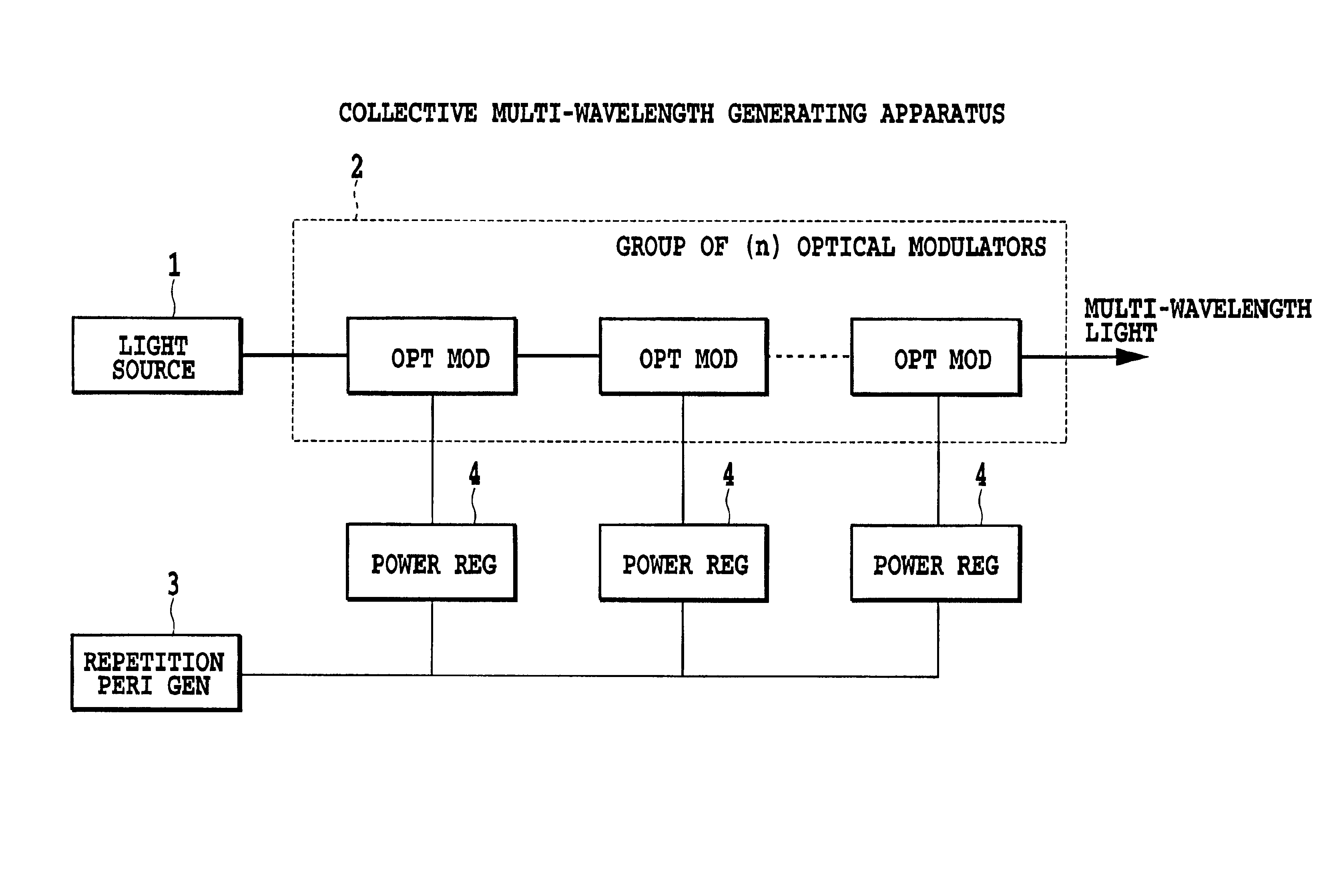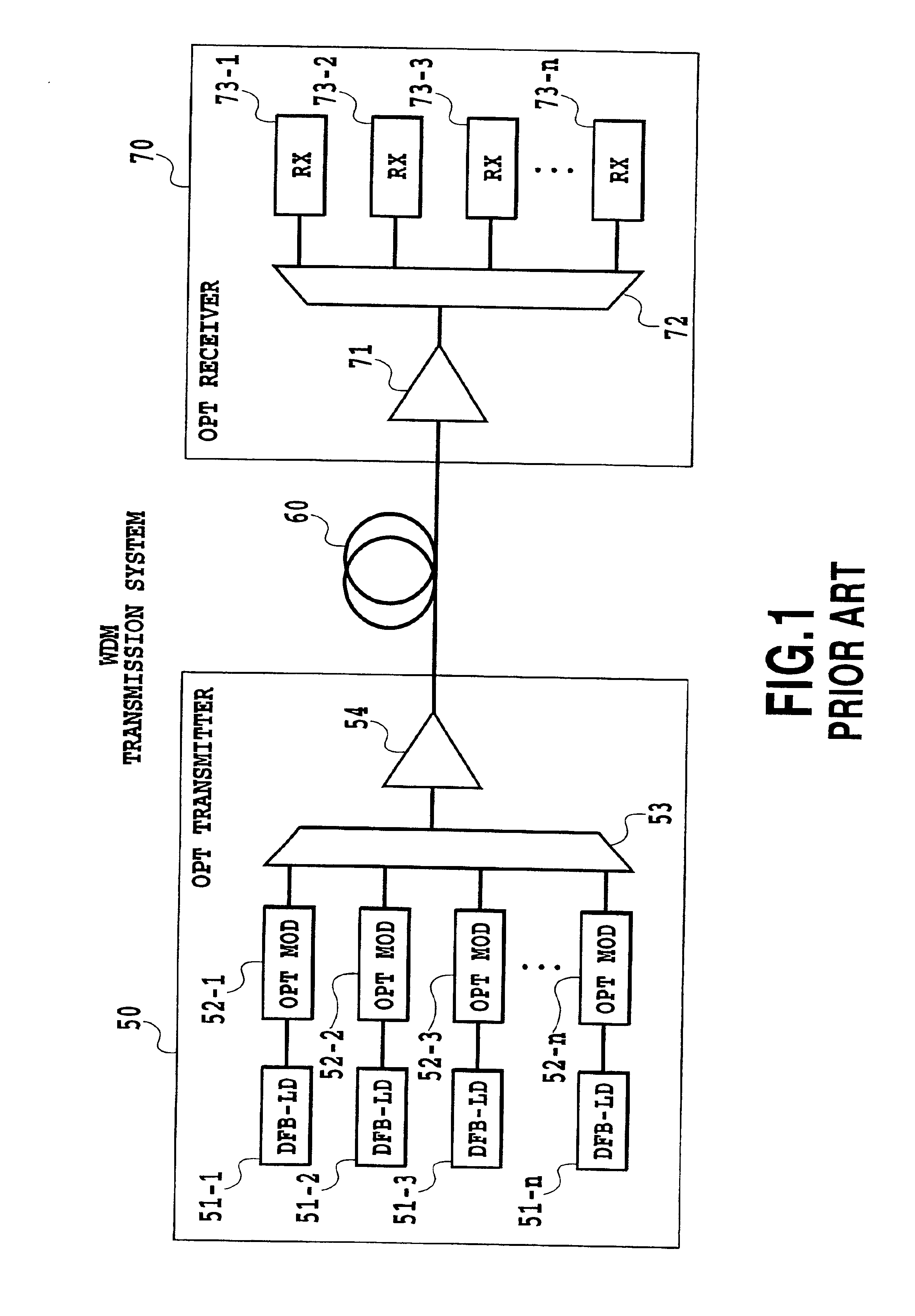Multi-wavelength generating method and apparatus based on flattening of optical spectrum
a multi-wavelength and optical spectrum technology, applied in multiplex communication, instruments, optical elements, etc., can solve the problems of inability to dynamically control the deviation of power level among longitudinal modes, incoherent and thus unsuitable for dense wdm transmissions involving a large number of wavelengths, and ineffective design and production
- Summary
- Abstract
- Description
- Claims
- Application Information
AI Technical Summary
Benefits of technology
Problems solved by technology
Method used
Image
Examples
eleventh embodiment
[Application of the Multi-wavelength Generating Apparatus]
FIGS. 49A and 49B are schematic views useful in explaining an applied operation of the twelfth embodiment of the multi-wavelength generating apparatus according to the present invention.
In the configuration shown in FIG. 45, the modulating sections possessed by the multi-wavelength generating apparatus 1620 and 1630 are a first and a second modulating sections, respectively. The wavelengths of lights incident on the modulating sections are offset from each other by a distance eight times as large as the intervals of the output multi-wavelength light.
FIG. 49A is a schematic view showing the relationship between both incident wavelengths in a case in which the multi-wavelength generating apparatuses 1620 and 1630 generate flattened 9-channel multi-wavelength lights and allow them to fall on the first and second modulating sections. As is apparent from this figure, the rightmost wavelength to the first modulating section overlap...
example 1
(Example 1 of Design of the Signal-to-noise Ratio SNR for Outputs from the Modulator)
In the coherent multi-wavelength signal generating apparatus shown in FIG. 50 or 51, the band of a receiver 373 of the WDM transmission system shown in FIG. 52 is defined as Be[Hz], the demultiplexing band of the demultiplexer 372 is defined as B.sub.0 [Hz], the signal mark rate is defined as M, the signal light intensity of an output from the i-th modulator is defined as P(i)[dBm], the intensity of the stimulated emission light in the output from this modulator is defined as Pc(i)[dBm], the intensity of the spontaneous emission light in the output from this modulator is defined as Ps(i) [dBm], an equivalent current flowing through the receiver is defined as Ieq[A], shot noise in the signal components is defined as Ns, the beat noise between the signal components and the spontaneous emission light is defined as Ns-sp, the beat noise between spontaneous emission light is defined as Nsp-sp, and therma...
example 2
(Example 2 of Design of the Signal-to-noise Ratio SNR for Outputs from the Modulator)
In the coherent multi-wavelength signal generating apparatus shown in FIG. 50 or 51, the band of a receiver 373 of the WDM transmission system shown in FIG. 52 is defined as Be[Hz], the demultiplexing band of the demultiplexer 372 is defined as B.sub.0 [Hz], the signal mark rate is defined as M, the signal light intensity of an output from the i-th modulator is defined as P(i)[dBm], the intensity of the stimulated emission light in the output from this modulator is defined as Pc(i) [dBm], the intensity of the spontaneous emission light in the output from this modulator is defined as Ps(i) [dBm], an equivalent current flowing through the receiver is defined as Ieq[A], the rate of leakage from the j-th port to the i-th port of the multiplexer is defined as XT(j), the light intensity of a cross talk signal from the multiplexer is defined as Px(i) [dBm], shot noise in the signal components is defined as...
PUM
 Login to View More
Login to View More Abstract
Description
Claims
Application Information
 Login to View More
Login to View More - R&D
- Intellectual Property
- Life Sciences
- Materials
- Tech Scout
- Unparalleled Data Quality
- Higher Quality Content
- 60% Fewer Hallucinations
Browse by: Latest US Patents, China's latest patents, Technical Efficacy Thesaurus, Application Domain, Technology Topic, Popular Technical Reports.
© 2025 PatSnap. All rights reserved.Legal|Privacy policy|Modern Slavery Act Transparency Statement|Sitemap|About US| Contact US: help@patsnap.com



